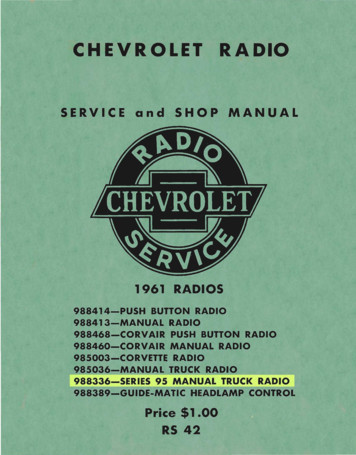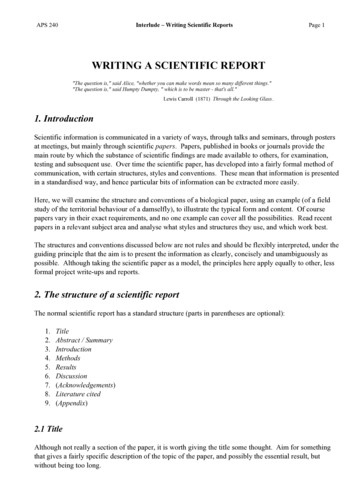Whisper Of Radio - CUHK
Whisper of RadioSpectrum Sharing in Cognitive Radio NetworksWei ZhangSchool of Electrical Engineering and TelecommunicationsThe University of New South WalesW. Zhang, Whisper of Radio, November 13, 2008. – p.1/39
Warm-up QuestionsQuestion 1: What are we doing in wirelesscommunications?W. Zhang, Whisper of Radio, November 13, 2008. – p.2/39
Olympic GameFaster, Higher, Stronger.W. Zhang, Whisper of Radio, November 13, 2008. – p.3/39
Warm-up QuestionsQuestion 2: What have we done in wirelesscommunications?W. Zhang, Whisper of Radio, November 13, 2008. – p.4/39
All Roads Lead to RomeWireless Communication is an “air travel”. What we have done isequivalent to increase passenger throughput.W. Zhang, Whisper of Radio, November 13, 2008. – p.5/39
All Roads Lead to RomeWireless Communication is an “air travel”. What we have done isequivalent to increase passenger throughput.add more airports - MIMOW. Zhang, Whisper of Radio, November 13, 2008. – p.5/39
All Roads Lead to RomeWireless Communication is an “air travel”. What we have done isequivalent to increase passenger throughput.add more airports - MIMObroaden runway to allow giant airplane (A340) - UWBW. Zhang, Whisper of Radio, November 13, 2008. – p.5/39
All Roads Lead to RomeWireless Communication is an “air travel”. What we have done isequivalent to increase passenger throughput.add more airports - MIMObroaden runway to allow giant airplane (A340) - UWBadd more lanes in runway - OFDMW. Zhang, Whisper of Radio, November 13, 2008. – p.5/39
All Roads Lead to RomeWireless Communication is an “air travel”. What we have done isequivalent to increase passenger throughput.add more airports - MIMObroaden runway to allow giant airplane (A340) - UWBadd more lanes in runway - OFDMborrow military airports - Cognitive RadioW. Zhang, Whisper of Radio, November 13, 2008. – p.5/39
OutlineIntroduction to Cognitive RadioResearch ChallengesWhispering RadioMultihop RelayingPerformance ResultsSummary & DiscussionW. Zhang, Whisper of Radio, November 13, 2008. – p.6/39
Spectrum ScarcityRadio spectrum is a limited resource, most has been exclusively allocated tolicensed systems and users.source: http://www.ntia.doc.gov/osmhome/allochrt.htmlW. Zhang, Whisper of Radio, November 13, 2008. – p.7/39
Spectrum Under-utilizationMost of the spectrum is largely under-utilized in vast temporal and geographicdimensions.M. A. McHenry, “NSF spectrum occupancy measurements project summary,” SharedSpectrum Company Report, Aug. 2005.W. Zhang, Whisper of Radio, November 13, 2008. – p.8/39
Cognitive RadioCognitive radio (CR) technology refers to a new type of radio that isaware of the environment in real time;self-adjustable to adapt to any corresponding variations, such asfrequency band, power, coding and modulation.CR is able to solve the conflicts between spectrum scarcity and spectrumunder-utilization by opportunistically accessing the licensed spectrum.W. Zhang, Whisper of Radio, November 13, 2008. – p.9/39
Cognitive Radio“Radio etiquette is the set of RF bands, air interfaces, protocols, and spatialand temporal patterns that moderate the use of radio spectrum. CR extendsthe software radio with radio-domain model-based reasoning about suchetiquettes.”J. Mitola and G. Q. Maguire, “Cognitive radio: Making software radios more personal,”IEEE Pers. Commun., vol. 6, pp. 13–18, Aug. 1999.W. Zhang, Whisper of Radio, November 13, 2008. – p.10/39
Cognitive Radio“Cognitive radio is an intelligent wireless communication system that is awareof its surrounding environment . and adapts its internal states to statisticalvariations by making corresponding changes in certain operating parameters(e.g., transmit power, carrier frequency, and modulation strategy) in real time,with two primary objectives in mind:Highly reliable communications whenever and wherever needed; andEfficient utilization of the radio spectrum.S. Haykin, “Cognitive radio: brain-empowered wireless communications,” IEEE J. Sel.Areas Commun., vol. 23, pp. 201–220, Feb. 2005.W. Zhang, Whisper of Radio, November 13, 2008. – p.11/39
Cognitive RadioMore specifically, the CR technology will enable the users to:Determine which portions of the spectrum is available and detect thepresence of licensed users when a user operates in a licensed band(spectrum sensing);Select the best available channel (spectrum management);Coordinate access to this channel with other users (spectrum sharing);andVacate the channel when a licensed user is detected (spectrum mobility).I. F. Akyildiz, et. al., “Next generation/dynamic spectrum access/cognitive radio wirelessnetworks: a survey,” Computer Networks, vol. 50, pp. 2127–2159, 2006.W. Zhang, Whisper of Radio, November 13, 2008. – p.12/39
Application: WRANWirelessMICTV TransmitterWRANBase StationWRANRepeaterWirelessMIC: WRAN Base StationTypical 33kmMax. 100km: CPEConsists of one base station (BS) and at least 512 simultaneously associatedconsumer premise equipments. Typical range of the system is 33 km. UtilizesUHF/VHF TV bands between 54 and 862 MHz.W. Zhang, Whisper of Radio, November 13, 2008. – p.13/39
OutlineIntroduction to Cognitive RadioResearch ChallengesWhispering RadioMultihop RelayingPerformance ResultsSummary & DiscussionW. Zhang, Whisper of Radio, November 13, 2008. – p.14/39
Challenge: Spectrum SensingPrimary RxSpectrum SensingPrimary TxPrimary SystemSecondaryUserSecondaryReceiverCognitive Radio SystemSpectrum sensing should detect the spectrum holes reliably and instantly.Hidden terminal problem. Cooperative spectrum sensing.W. Zhang, Whisper of Radio, November 13, 2008. – p.15/39
Challenge: RRMAllocate resources efficiently for potentially large available bands andpotentially huge number of usersAvoid interference to primary users (top priority accessing resources):Re-allocate resources upon detection of licensed users. How to guaranteeQoS?Co-exist with other non-licensed systems, e.g. resourcescompetition/lending/borrowingW. Zhang, Whisper of Radio, November 13, 2008. – p.16/39
Other Potential ChallengesSynchronization and channel estimation issues aroused fromhuge number of users, extremely wide band, collaboration with peersNew signaling schemes are required for the dynamic radio resourceCircuit-wise issuesoscillator design capable of hopping on a large set of differentfrequency bandsADC design capable of handling the potentially large dynamic range.W. Zhang, Whisper of Radio, November 13, 2008. – p.17/39
Our ContributionsCooperative Spectrum SensingCooperative Communications for CRInterference ManagementWhispering Radio6 Journal papers published and submitted3 US patents pendingW. Zhang, Whisper of Radio, November 13, 2008. – p.18/39
OutlineIntroduction to Cognitive RadioResearch ChallengesWhispering RadioMultihop RelayingPerformance ResultsSummary & DiscussionW. Zhang, Whisper of Radio, November 13, 2008. – p.19/39
Grey SpectrumThe spectrum of licensed channels can be classified as:White space – the spectrum where PU is inactive.Grey space – the spectrum where PU is in operation with low power.Black space – the spectrum where PU is in operation with high power.To exploit the grey spectrum, cognitive users (CU) should “speak”as loudly as possible to its desired listeners;as softly as possible not to annoy others, especially “supervisors”.W. Zhang, Whisper of Radio, November 13, 2008. – p.20/39
Speak, Whisper or Mute?P1 : the minimum Tx power of the CU which can reach its desired users.P2 : the maximum Tx power of CU which does not “annoy” the PU.Speak, Whisper or Mute?When PU is idle, CUs can freely access the “white space”. – Speak Mode.When PU is working and P1 P2 , CUs can only speak with a volume inthe range of [P1 , P2 ]. – Whisper Mode.When PU is working and P1 P2 , CUs keep silence. – Mute Mode.W. Zhang, Whisper of Radio, November 13, 2008. – p.21/39
Signal ModeliPItdirdtrrPSAssume Rayleigh block fading channels. The prob. µ of successfully receivinga packet isµ, h Θ(R N ) iRSI0Pr{SINR Θ} Pr{ Θ} EI exp RI N0RSΘ1·exp( ).(1)PdItrPS d α/Nα0{z tr} 1 ΘP (d ) Sir {z},µSNR,µSIRW. Zhang, Whisper of Radio, November 13, 2008. – p.22/39
Reliable TransmissionDefinition 1: The transmission of a CU is reliable if the successful prob. of theCU satisfies Pr{SINR Θc } ǫc .LpPUTxPpCRTxPURxuvCRRxdPcProposition 1: In the one hop CRN, for given QoS Θc and εc , the transmissionof CU is reliable iff its transmit power Pc satisfiesPc P1where P1 is given byΘcP1 log(1/εc ) PpN0 αu dα ,(2)W. Zhang, Whisper of Radio, November 13, 2008. – p.23/39
Transparent TransmissionDefinition 2: The transmission of a CU is transparent to a PU if thesuccessful prob. of the PU satisfies Pr{SINR Θp } ǫp .LpPUTxPpCRTxPURxuvCRRxdPcProposition 2: In the one hop CRN, for given QoS Θp and εp , the transmissionof CU is transparent to the active PUs iff its transmit power Pc satisfiesPc P2where P2 is given byP2 vLp α exp( Θ Lα ·p pεp Θ pN0)Pp εpPp(3)W. Zhang, Whisper of Radio, November 13, 2008. – p.24/39
Whispering RadioRemember whisper mode? P1 P2 . The distance d is the key to keep whispermode.Theorem 1: In the one hop CRN, TX could reliably and directly reach RX overa single hop while being transparent to PU iff the distance d is smaller thanDmaxpM u( 1 M 2 sin2 φ M u cos φ)Dmax ,(4)1 M2 1αlog(1/ε)P2cwhere M Pand φ is the angle between the CTx-CRx and·ΘcpPTx-CRx.Hint of proof : Substituting P1 into P1 P2 and using some geometry knowledge.W. Zhang, Whisper of Radio, November 13, 2008. – p.25/39
Black to GreyWhat if the whispering radio communications cannot be established betweenthe cognitive transmitter and receiver due to the long distance? In the case,spectrum is black to the CUs.Keep quiet? Spectrum inefficiency.Option: Keep whispering, but through relay nodes.Why: Since P2 is a constant (see Eq. (3)). The only option to guaranteeP1 P2 is to reduce P1 (see Eq. (2)) by shortening the distance d.W. Zhang, Whisper of Radio, November 13, 2008. – p.26/39
OutlineIntroduction to Cognitive RadioResearch ChallengesWhispering RadioMultihop RelayingPerformance ResultsSummary & DiscussionW. Zhang, Whisper of Radio, November 13, 2008. – p.27/39
Multihop Relay NetworkPUdLpPNPUsLssv2u3u2v3LddLcx1CUsΨd1sd2CU 1CU dd3d4CU 2CU 3d5CU 4CRNThe cognitive relay nodes are distributed in a homogeneous Poisson pointprocess with intensity λ. The length of the i-th hop is di .W. Zhang, Whisper of Radio, November 13, 2008. – p.28/39
MultihopIn the routing, the transmitter per hop attempts to find a relay node inside thesector Ψ such that the hop length di satisfies di Di,max (rf. Theorem 1).Di,maxCUiΨW. Zhang, Whisper of Radio, November 13, 2008. – p.29/39
Routing AlgorithmsNearest Neighbor Routing (NNR)Find the nearest node as relay in the sector Ψ within the distance Di,max .Hop distance is shorter, so the channel is more reliable, but need manyhops.Furthest Neighbor Routing (FNR)Find the Furthest node as relay in the sector Ψ within the distance Di,max .Less hops but each hop distance is long compared to NNR.W. Zhang, Whisper of Radio, November 13, 2008. – p.30/39
Multihop ReliabilityDefinition 4: Multihop reliability is the probability that a packet could besuccessfully delivered from the source to the destination.Over a route Rj , the end-to-end (e2e) reliability is the product of reliabilities(success probabilities) at each hop, i.e.,YµR j µi ,(5)i Rjwhere i Rj is the index of the node that belongs to route Rj andµi Pr{SINRi Θc }. Rj is the number of hops in route j.W. Zhang, Whisper of Radio, November 13, 2008. – p.31/39
Multihop ReliabilityTheorem 3: In a Rayleigh fading cognitive network, e2e reliability µR over amultihop route of N hops isµR NYµSNRii 1hiρP· 1 ,α1 uαP/(dΘ)ci c,ii(6)where µSNRi is the SNR of hop i (1) and ρP Pr{PU is ON}.Proof : Denote X the RV to indicate the PU activity.µR NYi 1hiµSNRi · µSIRi · Pr(X 1) Pr(X 0) .(7)W. Zhang, Whisper of Radio, November 13, 2008. – p.32/39
Multihop ReliabilityThe e2e reliability over relay route can be maximized by choosing anappropriate power value for each hop.Corollary 1: In a Rayleigh fading cognitive network, maximum e2e reliability is α βdciNexp Pcp,iY (1 ρP ) exp ( βc dαµmax (8)Ri ) ρPΘc1 rα Pcp,ii 1iHint of proof : µmaxis obtained by maximizing Pc,i .RW. Zhang, Whisper of Radio, November 13, 2008. – p.33/39
Performance Resultse2e reliability vs. position of 840.820.80.20.30.40.50.6d /d10.70.80.91cTwo-hop. A good relay is the one in the middle between source anddestination.W. Zhang, Whisper of Radio, November 13, 2008. – p.34/39
Performance Resultsµrelay µw/orelayµw/orelayThe reliability improvement by relaying. η 5r 0.94.543.5η32.52r 0.81.5r 0.710.50.10.150.2d0.250.30.351Larger PU traffic rate r, higher reliability improvement.W. Zhang, Whisper of Radio, November 13, 2008. – p.35/39
SummarySpectrum is largely under-utilized.Spectrum sharing between licensed user and secondaryuser is possible if cognitive radios are whispering.Multihop relaying can further enhance the spectrumefficiency by converting Black spectrum space into Greyspace.W. Zhang, Whisper of Radio, November 13, 2008. – p.36/39
Further DiscussionA smart routing is needed in which each hop length isalmost equal so as to maximize the reliability andconnectivity.Cognitive multiple access is desired to improve thethroughput of cognitive networks.Distributive resource allocation (power control, timeallocation, frequency sharing factor, etc.)W. Zhang, Whisper of Radio, November 13, 2008. – p.37/39
AcknowledgementsThanks go to my collaborators at HKUST and UCL.Prof. Khaled Ben Letaief, HKUST, Hong Kong.Miss Karama Hamid, HKUST, Hong Kong.Dr. Kai-Kit Wong, UCL, UK.Dr. Min Xie, UCL, UK.W. Zhang, Whisper of Radio, November 13, 2008. – p.38/39
Thank you!Questions?W. Zhang, Whisper of Radio, November 13, 2008. – p.39/39
Cognitive Radio “Radio etiquette is the set of RF bands, air interfaces, protocols, and spatial and temporal patterns that moderate the use of radio spectrum. CR extends the software radio with radio-domain model-based reasoning about such etiquettes.” J. Mitola and G. Q. Maguire, “Cognitive radio: Making software radios more personal,”
WHISPER ORDER MATRIX (Example: WS-IC-2790-S1 Whisper Downlight, IC Rated, 2700K, 90 CRI, Integral Universal Dim driver) PRODUCT FAMILY CCT CRI INTEGRAL DRIVER OPTIONS Includes Whisper with Integral Driver WS-IC-Whisper Downlight IC Rated New Construction or Remodel 27 30 35 40 (2700K) (3000K) (3500K)
Semi-Supervised Monocular 3D Face Reconstruction With End-to-End Shape-Preserved Domain Transfer Jingtan Piao Chen Qian Hongsheng Li CUHK-SenseTime Joint Laboratory, The Chinese University of Hong Kong Sensetime Research 1155116308@link.cuhk.edu.hk qianchen@sensetime.com hsli@ee.cuhk.edu.hk Abstrac
SERVICE and SHOP MANUAL 1961 RADIOS 988414-PUSH BUTTON RADIO 988413-MANUAL RADIO 988468-CORVAIR PUSH BUTTON RADIO 988460-CORVAIR MANUAL RADIO 985003-CORVETTE RADIO 985036-MANUAL TRUCK RADIO 988336-SERIES 95 MANUAL TRUCK RADIO 988389-GUIDE-MATIC HEADLAMP CONTROL Price 1.00 . 89 switch and must be opened by speaker plug when testing radio.
Wavestown Answer Key Radio Waves Ray’s TV - TV reception uses radio waves Satellite Dish on top Ray’s - receives movies via radio waves from a satellite Taxi - Car radio reception uses radio signals Taxi - Driver receives instructions on a CB radio which uses radio waves Radio Tower - broadcast’s radio signals
Radio and TV Back Price List (prices valid through 12/31/18) Addison 2 or 2A Radio Back 22.99 Admiral 15-D5 Radio Back 23.99 Admiral 150-5Z Radio Back 24.99 Admiral 7T10M-N Radio Back 22.99 Aircastle 106B Radio Back 22.99 Airline 04BR-514B Radio Back 22.99 Airline 14BR-525A Radio Ba
6 x 4 x 2‐1/2 2,875 Egal pourcentage, linéaire, Whisper I, Cavitrol III (2 étages) V (pour diamètres d'orifices de 2,875 à 8 in. avec éléments internes C‐Seal en option) 6 x 4 8 x 4 4,375 Egal pourcentage, linéaire, Whisper I, Cavitrol III (1 étage) 8 x 6 et 12 x 6 5,375 Whisper III
Vikas Agarwal vagarwal@gsu.edu Robinson College of Business Georgia State University Brad Barber bmbarber@ucdavis.edu Graduate School of Management UC Davis Si Cheng sicheng@cuhk.edu.hk CUHK Business School Chinese University of Hong Kong Allaudeen Hameed allaudeen@nus.edu.sg NUS Business School National University of Singapore Ayako Yasuda asyasuda@ucdavis.edu Graduate School of Management UC .
APS 240 Interlude Ð Writing Scientific Reports Page 5 subspecies of an organism (e.g. Calopteryx splendens xanthostoma ) then the sub-species name (xanthostoma ) is formatted the same way as the species name. In the passage above you will notice that the name of the damselfly is followed by a name: ÔLinnaeusÕ. This is the authority, the name of the taxonomist responsible for naming the .























